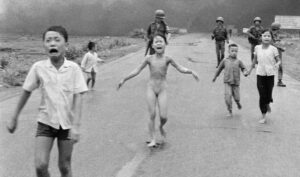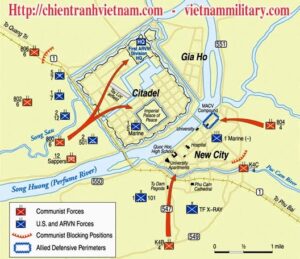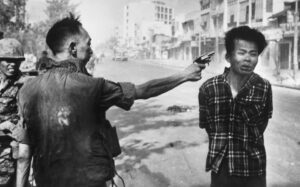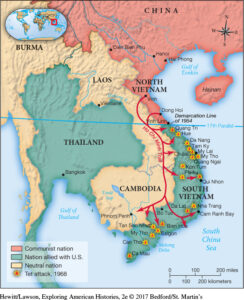By Long Bui
By the year 1967, the Vietnam war escalated to a scale that had never been before. Almost 400.000 American troops and 750.000 Army of the Republic of Vietnam’s (ARVN) soldiers operated across Southern Vietnam’s rural regions to conduct massive campaigns against further communist expansion by the Viet Cong (VC) and the People’s Army of Vietnam (PAVN). [1] Khe Sanh became the climax of this confrontation which a hundred thousand tons of bombs and artillery rounds were fired from the defense base every month. [2] However, on the home front, an impending disaster was secretly approaching the US and its allies that would later disrupt the Pentagon’s strategic calculation of the war and weakened US public support for the conflict, later known as the 1968 Tet Offensive.
The author of American Dreams, H.W.Brands, indicated that the Tet Offensive severely paralyzed the US strategy in Vietnam since the campaign had successfully “revealed a capacity for command and control among communists that American officers and civilian officers hadn’t suspected.” [3] Specifically, the reminiscence of former communist Vietnamese lieutenant, Bui Ngoc Minh, will provide further descriptive insights into how the VC and PAVN infiltrated into southern urban areas and coordinated with each other to launch such a surprise attack. Although Brands stated that the Tet Offensive proved to be “a psychological and moral triumph” [4] for the communist camp, from Minh’s perspective, the brutality and bloodshed during the campaign left haunting memories not only for Americans who witnessed the incident but also for the communist soldiers who participated in this campaign, reflecting the desire for an end to a decades-long conflict from both sides.
In the summer of 1967, captain (his rank at that time) Minh was then working as a platoon officer in the VI Artillery Regiment of the 6th Division which frequently operated along the Ho Chi Minh trails. Surprisingly, he received an order to infiltrate Hue, Southern Vietnam. “At that time, I was a little bit shocked that a technical engineer like me was ordered to be an undercover agent”- Minh recounted. [5] However, neither did Minh know that he was participating in the most elaborate and influential campaign in the war. In fact, even the MACV commander, general William Westmoreland and his staff, acknowledged that the communists were adjusting their grand strategy but never thought of such a magnitude would be unleashed right inside their heartlands. [6]
According to the plan, captain Minh would lead his platoon along Ho Chi Minh trails to Svay Rieng, Cambodia, and then intrude into the Southern Vietnam border. After five years of special operations, Vietnam’s rural areas had been severely destabilized, creating massive refugee caravans in the region. Captain Minh described: “The refugee caravans were chaotic, running from the warzones and as far as possible. Some moved to the city; some went to foreign countries; and some just wanted to run away”. [7] Therefore, he stated, “This made us easily infiltrate into the system since American troops hardly ever took serious concern about the refugees due to the human rights crisis”. [8] Taking this advantage, his team gradually walked along the HCM trails, to Svay Rieng, and then arrived at Hue just after one month. [9]

“The Terror of War”, also known as the “Napalm Girl”, is a Pulitzer Prize winning photograph taken by photojournalist Nick Ut, a Vietnamese American photographer who was working for the Associated Press at that time. The picture depicted children were running away from bombarding areas in a countryside of Southern Vietnam.
Thanks to the lack of attention to the urban espionage process, Minh successfully joined the communist intelligence network in Hue in a short matter of time. Arriving at Hue, he followed the order to wait under the Da Vien bridge. After five hours of waiting, a child suddenly approached Minh to give him a small bag, and then the kid ran away. Looking inside the bag, he received his fake ID, other legal papers, money, and a coded letter that had his next mission. “My next task is to decoy as a man named Tám who owned and operated a small firework business and then won a bid for a firework slot in North West of Hue”- Captain Minh recalled. [10] The unstable and corrupted condition of the Southern Vietnam government made the deception easier for him to complete this goal. Through intelligence assistance and bribery, Minh quickly approached different local officials in the district. However, as long as he got in touch with these people, he realized that they almost all came from the same family. He indicated: “You do not need to corrupt them, they were corrupted in the beginning”. [11] In fact, the instability in the South had become an intriguing problems that according to historian James H. Willbanks, there are evidence that “weapons arrived in trucks loaded with flowers, vegetables and fruits destined for the holiday celebration (Tet)” and some VC soldiers even “dressed in ARVN uniforms to mingle with crowds of South Vietnamese cilvilian” before the incident. [12] Therefore, taking advantages of the situation, he successfully won a firework-operating slot in North West Hue along the main road of Tang Bat Ho.

The battle of Hue 1968. Although the Red arrows indicates attacking directions of communist forces, there are still communist infiltrations before the battle that the picture does not include. Captain Minh and his platoons were fighting in the furtherst NorthWest arrow.
Although People in Minh’s team were not firework operators but instead, anti-air artillery operators, they gradually realized the decision behind deceiving the firework systems. He demonstrated: “Once we got in touch with fireworks, we discovered that fireworks and guns all originated from gunpowders and made the same sound”. [13] Then, he continued: “We then find a way to make the fireworks explode as long as possible to create a decoy for gun sounds abrupting when our comrades attacked the city”. [14] In the end, they came up with the plan of interleaving the gun sounds and the fireworks abruptions with each other so that the enemies could not be aware of the attack.[15]

Execution of a VietCong soldier by a Southern Vietnamese brigadier during the Tet Offensive in the street of Saigon. The photograph would later become one of the most influential catalyst to anti-war movements in America. (Video: https://www.youtube.com/watch?v=csYYBOytkZM)
The night fell. At midnight the fireworks started and these fireworks lasted longer than any years before. As captain Minh indicated: “I was amazed how synchronized these fireworks happened in every district at that moment. At that time, I couldn’t believe that our comrades were literally everywhere in the city.” [16] The sound of fireworks and guns step-by-step became more mixed with each other and harder to identify. The fight became more extreme, spreading across the city. Guns and explosions became more astonishing than the sounds of the fireworks. In the street, many VC and VPA soldiers formerly dressed as civilians regrouped and occupied strategic buildings. Unable to identify the enemies, Hue’s police cadets were confused and acted violently. [17] They started to shoot any suspects including many civilians in the street, creating a bloody and chaotic scene in Hue. Captain Minh, with his team, ran into a building to find a shelter between the merciless fires from both sides.[18]
The street came into chaos and behind gun dust and shootings, a man wearing a VPA’s uniform with an AK-47 in his hand approached him and asked: “Are you captain Minh of 3rd battalion under 6th regiment, comrade?” Realizing the three stars in his epaulets, he understood that he was meeting with general Tran Do, the leader of the 6th regiment, then he stood straight and saluted the general, answering: “Yes, I am, general”. [19] Then, general Do greeted him and his men for their success and asked them to regroup with the remaining people of the battalion who were fighting in the district. In just several hours, they captured the main road of Tang Bat ho and the surrounding area. The Southern army in Hue and the local forces were stunned by the attacks; they were dispersed across the city to stay with their family and the sudden attack made them unable to regroup and resist the attack. [20] “Hardly any American troops are being seen in the city”- Captain Minh recalled. [21] In fact, many of them were encamped several miles South-East of Hue in Phu Bai airbase and had not been informed fast enough of the sudden attack.[22] According to captain Minh, the attack on Hue was a race. He explained: “If we were able to take most of Hue when the sun came in, the US would not be able to use their air superiority and bombard the city since the city had many historical sites”. [23] Therefore, in the morning, the VPA and VC had been able to capture most of the city and by dusk on the same day, the Communist flag waved on the top of the Imperial Citadel, marking the total collapse of the ancient capital.
After the capture of the city, general Do organized a meeting consisting of captains and lieutenants to congrats on the victory. However, he stated that this was not an ultimate victory and we still had more battles to fight. Then, he took out a paper that consisted of names that he condemned as “cruel tyrants and reactionary elements” which should be exterminated. [24] In the beginning, everyone agreed with these decisions but “generals were not executives”-captain Minh insisted. [25] There were no real trials and the problems of whether their families would take revenge or fight against the newly established regime in Hue became an intriguing question for the top military commanders. As a result, many decided that the victims and their family members would share the same fates with them to prevent further security threats. Once blood is spilled, more blood will be spilled. The universal acceptance of executions became popularized and soldiers began to execute other people for different reasons from personal conflicts to lynching. Consequently, this never brought any peace and the communist forces were being pushed out after 3 weeks of occupation.
Reflecting on the incident, he stated: “Now remembering the war, we usually blamed Americans for their imperialism. But many of us have forgotten how we, ourselves, did horrible things to our own people”. [27] He continued: “But you know, the point of that war was to kill and exterminate people who just believe things that are different from you. Was there really a legitimacy for the war from the start ?” [28] The soldiers witnessed these atrocities and the high-ranking officials heard about the statistics and reports. Although the discussion about peace in the North was long forbidden, it was clear that in many communist top officials’ perspective, de-escalation was necessary and a peace negotiation was vital. Similarly, in America, after the incident, major protests broke out across the country to stand up against the ongoing conflict, forcing US officials to reshape their approaches to the war. On March 31, president Lyndon B. Johnson addressed the American people: The US is ready to “discuss the means of bringing this ugly war to an end.” [29] Although the US retrieved its army from Vietnam 5 years later, as Brands indicated, the Vietnam War had “seared itself on the American mind, replacing the Munich Syndrome with a Vietnam Syndrome”. [30]
Footnotes
[1]: James H. Willbanks, The Tet Offensive: A Concise History, (New York: Columbia University Press, 2007), 7.
[2]: Athony Tucker-Jones, The Vietnam War : the Tet Offensive, 1968, (South Yorkshire, England: Pen & Sword Military, 2014), 99.
[3]: H.W. Brands, American Dreams: The United States Since 1945 (New York: Penguin Books, 2010), 156.
[4]: H.W.Brands, 156.
[5]: Interviews with Bui Ngoc Minh, April 24, 2022.
[6]: James H. Willbanks, 27.
[7]: Interviews with Bui Ngoc Minh, April 30, 2022.
[8]: Interviews with Bui Ngoc Minh, April 30, 2022.
[9]: Interviews with Bui Ngoc Minh, April 30, 2022.
[10]: Interviews with Bui Ngoc Minh, April 30, 2022.
[11]: Interviews with Bui Ngoc Minh, April 30, 2022.
[12]: James H. Willbanks, 26.
[13]: Interviews with Bui Ngoc Minh, April 30, 2022.
[14]: Interviews with Bui Ngoc Minh, April 30, 2022.
[15]: Interviews with Bui Ngoc Minh, April 30, 2022.
[16]: Interviews with Bui Ngoc Minh, April 30, 2022.
[17]: Athony Tucker-Jones, 111.
[18]: Interviews with Bui Ngoc Minh, April 30, 2022.
[19]: Interviews with Bui Ngoc Minh, April 30, 2022.
[20]: Athony Tucker-Jones, 111.
[21]: Interviews with Bui Ngoc Minh, April 30, 2022.
[22]: Athony Tucker Jones, pg. 112-113.
[23]: Interviews with Bui Ngoc Minh, April 30, 2022.
[24]: James H. Willbanks, 45.
[25]: Interviews with Bui Ngoc Minh, April 30, 2022.
[26]: Interviews with Bui Ngoc Minh, April 30, 2022.
[27]: Interviews with Bui Ngoc Minh, April 30, 2022.
[28]: Interviews with Bui Ngoc Minh, April 30, 2022.
[29]: H.W.Brands. 158.
[30]: H.W.Brands, 175.
Pictures, photographs, and video: clicking into pictures/ photographs/ video for further information.
Interview subjects
Bui Ngoc Minh, age 86, retired VPA lieutenant who participated in the Vietnam War as an operative officer in the Ho Chi Minh Trails and intelligent officer during the Tet Offensive.
Zalo, April 30, 2022.
Selected Transcript
Q: Did you remember the Tet Offensive? I knew that you were a spy during that campaign but previously, you were an operative officer, so how could the infiltration process happen so quickly ?
A: The instability in the South made the espionage expansion more effective. After the (1963) coup, the South became increasingly destabilized with regional military factions and corrupted government officials. However, the US military intervention made it worse. The Seek and Destroy Operation devastated the rural areas and created huge swarms of refugees moving into cities and Cambodia. The refugee caravans were chaotic, running from the warzones and as far as possible. Some moved to the city; some went to foreign countries; and some just wanted to run away. This made us easily infiltrate into the system since American troops hardly ever took serious concern about the refugees due to the human rights crisis. I took the order with my comrades, following the refugees to Svay Rieng (South East Cambodia) and then re entered Vietnam and just after a month, I had completed my trip.
Arriving at Hue, I disguised myself as a businessman who owned a firework company and then with some help from the inside, we were able to bribe the government officials to organize that year’s firework celebration in a part of Hue.
Q: Well, my high school teacher also mentioned him once. However, I am still wondering why the government officials did not suspect you ?
A: They thought it was just companies trying to compete with each other and the officials at that time were extremely corrupt so they just considered bribery as normal.
Q: The plan seemed to go on very well. But you remember how the campaign officially started?
A: So when the moment transitioned from the old year to the new year, also the time when we had to shoot fireworks, I ordered my team to place fireworks in the populated areas. Many simply thought we just wanted to attract attention and advertised our company. However, we really want to distract citizens from the guns’ sounds that the LSAV attacked in the middle of the night. The plan was a resounding success! This was the most unforgettable moment for me…..*he laughed*….. The moment that fireworks were shot around every city and every corner of every city, I knew that we would win this war. We had the legitimacy and I understood that if the Americans wanted to achieve their goals, they had to kill every single Vietnamese. Later, after the war, I acknowledged that this event was broadcasted everywhere. The scenario in which a well-equipped US soldier fought against a peasant with an AK made the people in the world think of the US as invaders and us as heroic fighters for independence.
But I could not held my happiness for long, the enemies soon realized that there were communist soldiers in the city. Even just a small number, they created more chaos in the street, shooting everyone they assume as communists. Many of my comrades fell down that moments. However, the majority of the enemies troops did not respond fast enough and could not regroup on time to counter the attack. Luckily, Hardly any American troops are being seen in the city.
At that time, a general met me and ordered me to regroup with my division and continued the fight. The attack was a race of time. If we were able to take most of Hue when the sun came in, the US would not be able to use their air superiority and bombard the city since the city had many historical sites. We advanced from columns to columns and buildings to buidings. At 12, we successfully captured majortiy of the Imperial Citadel.


